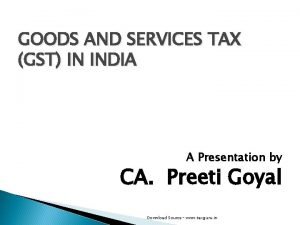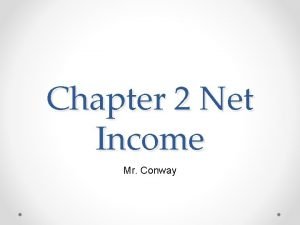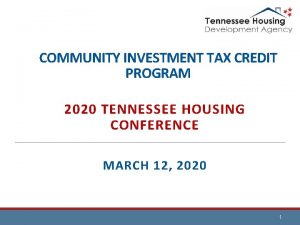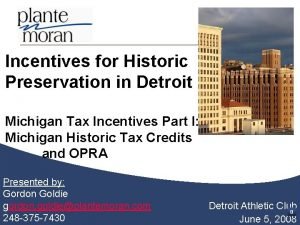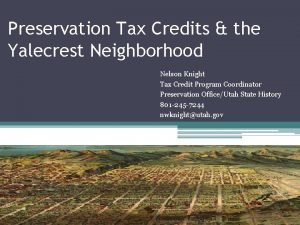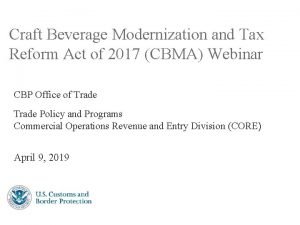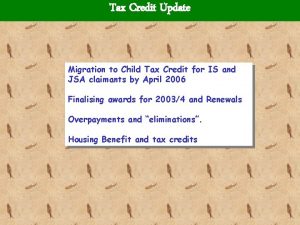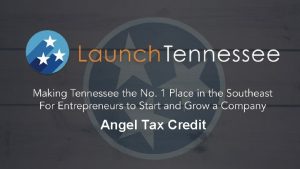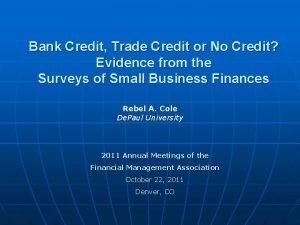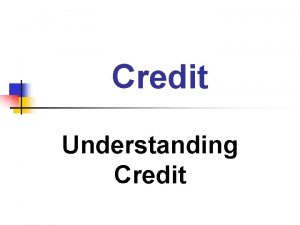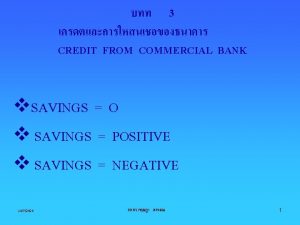Tax Credit Originally the tax credit was refunded












- Slides: 12


Tax Credit Originally, the tax credit was refunded quarterly. Now, you can take the full amount of the Emergency Sick Leave as a credit on your taxes due. **Webinar on Thursday at 11: 00: Deep dive on how the tax credit works.

When does this go into effect? April 2, 2020 - December 31, 2020 4. 2. 2020 First date an employee can use the Emergency Paid Sick Leave and the Emergency Family Medical Leave

Paid Family Medical Leave EFMLA: Emergency Family and Medical Leave Expansion Act • The bill provides 12 weeks of job-protected paid EFMLA – of which the first 10 days may be unpaid – for employees of employers with under 500 employees • Employees may use accrued personal or sick leave during the first 10 days, but employers may not require employees to do so • This leave benefit covers employees who have been working for at least 30 calendar days • If employees are unable to work or telework and school or place of care has been closed related to a public emergency, employees may use leave to care for a child under the age of 18. • After the first 10 days, employers must compensate employees in an amount that is not less than 2/3 of the employee’s regular rate of pay based on their normal scheduled hours. These pay requirements apply to only the COVID-19 related leave reasons listed above. • The provisions will go into effect 15 days after the date of enactment and expire on December 31, 2020

Emergency Paid Sick Leave Act • Employers will be required to post a notice informing employees of their rights to leave within 7 days of enactment of the law. • 4. 2. 2020 is the enactment of law. You have to post notice by 4. 9. 2020. • Waiting on the model notice language from DOL (Wednesday).

I-9’s • Employers with employees taking physical proximity precautions due to COVID-19 will not be required to review the employee's identity and employment authorization documents in the employee's physical presence. • Employers that avail themselves of this option must provide written documentation of their remote onboarding and telework policy for each employee. • Employers must still inspect the Section 2 documents over video conference, fax, or e-mail and obtain and retain copies of the documents within three business days. Employers are instructed to enter "COVID-19" as the reason for the physical inspection delay in the additional information field in Section 2.

I-9’s • Once normal operations resume, all employees who were onboarded using remote verification must report to their employer within three business days for in-person verification of their identity and employment eligibility documentation. Once the documents have been physically inspected, the employer should add "documents physically examined" with the date of inspection to the Section 2 additional information field. • The provisions are in effect until May 19 th or within three business days after the termination of the national emergency, whichever comes first.

Virginia-Retail Businesses The following retail businesses are considered essential and may remain open during normal business hours: • Grocery stores, pharmacies, and other retailers that sell food and beverage products or pharmacy products, including dollar stores, and department stores with grocery or pharmacy operations; • Medical, laboratory, and vision supply retailers; • Electronic retailers that sell or service cell phones, computers, tablets, and other communications technology; • Automotive parts, accessories, and tire retailers as well as automotive repair facilities; • Home improvement, hardware, building material, and building supply retailers; • Lawn and garden equipment retailers; • Beer, wine, and liquor stores; • Retail functions of gas stations and convenience stores; • Retail located within healthcare facilities; • Banks and other financial institutions with retail functions; • Pet stores and feed stores; • Printing and office supply stores; and • Laundromats and dry cleaners.

FAQ Q: Are you allowed to force employees to deplete PTO first during these two weeks? A: Employees can choose to use their accumulated sick or PTO during the first two weeks of EFMLA, but you cannot force them to do so. They can also use the Emergency Paid Sick Leave for those two weeks as well. Q: What happens if employees have already used their FMLA? Do they get an additional 12 weeks? A: Yes, they are eligible for an additional 12 weeks of EFMLA - which is to care for a child who is home due to a school or daycare closure or a day care provider being unavailable due to a COVID-19 reason.

FAQ Q: If the employees are laid off today and still laid off after April 2 nd, would they start getting the paid time off starting April 2 nd? A: Employees that are laid off (terminated) are not eligible for Emergency Sick Pay nor Emergency FMLA. If they are furloughed, or temporarily laid off, and not terminated, they may be eligible to take the paid sick leave benefit (up to 80 hours) provided for in the Act if they get sick themselves. We are waiting for clarification on this. Q: What is the difference in furlough and layoff? A: furlough is a temporary layoff or reduction in force with the goal of reinstating employees as business needs dictate. These employees are not considered to be terminated and could even still be covered by health insurance. A layoff is more permanent in nature and involves terminating the employee. In both cases, the employee is eligible to apply for unemployment if earnings have been reduced or eliminated.

Questions we still getting clarification on: • Can the EFMLA and EPSE be used intermittently? • What are the guidelines around unemployment? • What is the Healthcare Workers exemptions? • Does anyone know if the SBA Economic Injury Disaster Loans must be guaranteed by small business owners or are they backed by the SBA/government? • Any disadvantages of having your employees simply go ahead and file for unemployment since our office is closed? Do we have to make them use all their PTO/Sick days before they file unemployment?

Questions? We’re Here to Help! View webinar schedule, daily updates, templates, & resources at: https: //empower. dominionpayroll. com/covid-19 updates Email us at: questions@dominionpayroll. com
 Conclusion of gst
Conclusion of gst Find the local tax deducted: $456 biweekly, 2 1/2 % tax.
Find the local tax deducted: $456 biweekly, 2 1/2 % tax. Solidarity tax credit eligibility
Solidarity tax credit eligibility Community investment tax credit tennessee
Community investment tax credit tennessee Michigan historic tax credit
Michigan historic tax credit Input tax credit meaning
Input tax credit meaning Michigan historic preservation tax credit
Michigan historic preservation tax credit Utah historic preservation tax credit
Utah historic preservation tax credit Historic tax credit structure diagram
Historic tax credit structure diagram Historic tax credit syndication
Historic tax credit syndication Form 8962 premium tax credit
Form 8962 premium tax credit Cbma tax credit
Cbma tax credit Ey r&d tax credit
Ey r&d tax credit
